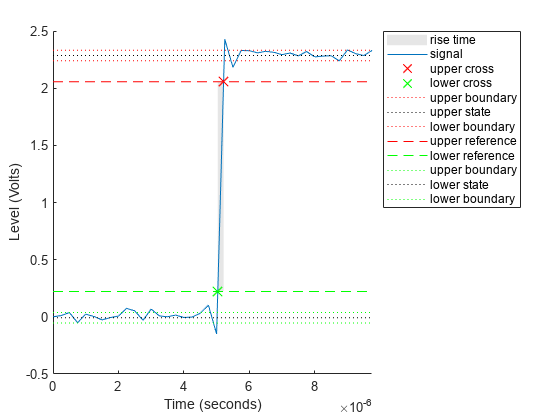risetime
Rise time of positive-going bilevel waveform transitions
Syntax
Description
r = risetime(x)r, containing the time each transition of
the input bilevel waveform, x, takes to cross from the 10%
to 90% reference levels. To determine the transitions,
risetime estimates the state levels of the input
waveform by a histogram method. risetime identifies all
regions that cross the upper-state boundary of the low state and the lower-state
boundary of the high state. The low-state and high-state boundaries are
expressed as the state level plus or minus a multiple of the difference between
the state levels. See State-Level Tolerances. Because risetime
uses interpolation, r can contain values that do not
correspond to sampling instants of the bilevel waveform,
x.
r = risetime(x,fs)x. The first
sample instant in x corresponds to t = 0. Because risetime uses interpolation,
r can contain values that do not correspond to sampling
instants of the bilevel waveform, x.
[___] = risetime(___,
returns the rise times with additional options specified by one or more
name-value arguments.Name=Value)
risetime(___) plots the signal and darkens
the regions of each transition where rise time is computed. The plot marks the
lower and upper crossings and the associated reference levels. The state levels
and the corresponding associated lower- and upper-state boundaries are also
plotted.
Examples
Input Arguments
Name-Value Arguments
Output Arguments
More About
References
[1] IEEE® Standard on Transitions, Pulses, and Related Waveforms, IEEE Standard 181, 2003, pp. 15–17.
Extended Capabilities
Version History
Introduced in R2012a







